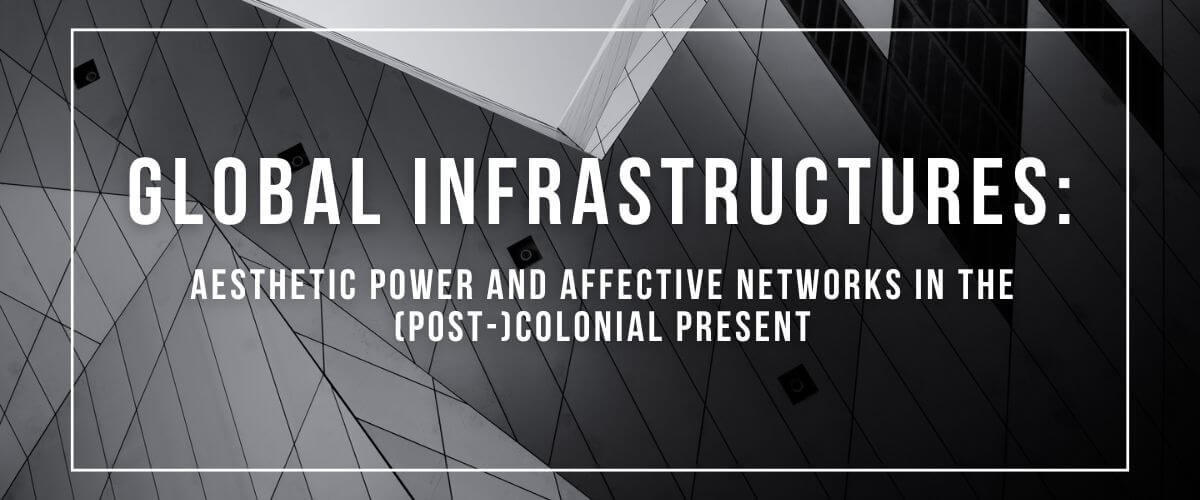november, 2024

Event Details
Workshop that promotes a collective investigation of the aesthetic and affective dimension of global infrastructures. Global Infrastructures: Aesthetic Power and Affective Networks in the (Post-)colonial Present Since the nineteenth
more
Event Details
Workshop that promotes a collective investigation of the aesthetic and affective dimension of global infrastructures.
Global Infrastructures:
Aesthetic Power and Affective Networks in the (Post-)colonial Present
Since the nineteenth century, an ever-more complex web of roads, railways, airports, oil pipelines, shipping lanes, fiber-optic cables, tunnels, aqueducts, gas networks, and electrical systems sustains and supports modern life. Built above, through and below the ground, infrastructural systems constitute foundational sociotechnical assemblages of modern societies: a series of installations that shape both biological and social life. A number of scholars – working across several disciplines – have begun interrogating the aesthetic dimension of these infrastructural systems, pointing to their ability to induce a “feeling of modernity”.
From this perspective, the most symbolic infrastructures of modernity – high-speed railways, paved roads, and electric cable wires – endlessly project imagined futures of industrial comfort and logistical speed. They have long objectified the Enlightenment idea of a world in motion and open, aimed at progress. Reflecting on how embodied experiences are governed by the ways infrastructures continuously produce the “ambient conditions of everyday life”, Brian Larkin stresses that “the materials of infrastructure—the hardness of the road, the intensity of its blackness, its smooth finish—produces sensorial and political experiences”. The infrastructuralisation of lived environments not only structures new ways of producing commodities and reproducing material lives, but it also reshapes the way in which everyday life is subjectively experienced, conceptualized and imagined.
As shown by Rudolf Mràzek in his analysis of the material and symbolic role of colonial infrastructure in early twentieth-century Indonesia, the very materials of which infrastructures are composed shape “a sensory apprehension of existence”, and often historically encapsulate how political power is abstractly imagined and practically administered. The imposition of hard roads over the muddy, soft paths of Indonesia is not only a powerful metaphor for how colonial power operates; rather, it is a constitutive element of that system of power and how it is subjectively experienced by both colonizers and colonized. The infrastructural systems built by the Dutch in colonial Indonesia have been constitutive of a symbolic language and generative of new conceptions of historical time, geographical space and social relations. Infrastructures, in other words, are material formations that continuously interact and co-constitute social systems of ideology, meaning, and imagination.
This methodological intuition can be usefully applied to further nuanced understandings of the aesthetic and ideological dimensions of infrastructure. Mud, concrete, iron, plastics, and glass possess physical properties that, while functionally exploited to further specific infrastructural projects, constitute different sensorial experiences, relational effects, and modes of thinking about the world. The analytical centrality of matter has been experiencing a new spring. Tony Bennett and Patrick Joyce were among the first to speak of a ‘material turn’ in the social sciences, arching back to classic works by Michel Foucault, Gilles Deleuze, Felix Guattari and Bruno Latour. These authors, in their own ways, have interrogated the materiality of power by examining the infrastructural apparatuses that sustain their everyday operations. This is a programmatically ‘superficial approach’ to the study of politics and society because “it is the surface itself that constitutes the level on which semiotic and material relation are inseparably connected to each other”. Infrastructural surfaces, in particular, channel and shape individual conducts and social relations.
Think of the surface geometries of nineteenth-century North American railroads, for instance. Endless sequences of wooden sleepers, supporting parallel iron planks whose materiality ensured the stability on which unprecedented speed could be sustained. Railroads tantalized the imaginations of both settlers and natives as “Matter and the relationship to the nonhuman,” Anand, Gupta and Appel recall, “are not just an inert substrate that yields to the dreams and desires of powerful (human) actors. Rather, infrastructure materials are active participants in their form and, therefore, also in their political”. The sense of awe and fascination these structures stimulate was and continues to be a fundamental part of their political effect. Conceptually rooted in the idea of a world in motion, the railroad was inextricably linked to progressive ways of thinking and what Paul Virilio called a modern politics and aesthetics of speed. The fascination for the machinic acceleration enabled by modern infrastructures has been, arguably, one of the main legacies of twentieth-century industrialism and imperialism. How are modernist bodily sensations and future-looking imaginations at once furthered and reconfigured by emerging infrastructural forms such as the digital platforms that support companies such as Google and Amazon, or the living infrastructures that characterize biotech capital? How are these material formations linked to new aesthetic tendencies and social imaginations? What infrastructural affects characterize our own infrastructural present?
Infrastructures, however, have always been – and continue to be – sites of resistance and contestation. While they are designed by state planners and corporate architects, they are often lived by multitudes of human and non-human subjects. The material geometries of global infrastructures are populated by alternative dreams, desires and practices that betray and shift away from the original intentions of those who fund their construction and own their surfaces. Infrastructures are not only means of power, but also sites of creativity and resistance. They remain ever-unstable battlegrounds over which material and aesthetic struggles are fought, and subversive dreams and desires are projected. How is this politics of infrastructure being fought today? And what aesthetics and affective dimension does it take?
>> Programme (PDF) <<
Call for papers
Following this line of investigation, the workshop intends to focus on infrastructures as semiotic and aesthetic vehicles. It promotes a collective investigation of the aesthetic and affective dimension of global infrastructures, emphasizing how it interacts with colonial projects, capitalist ventures, and cultural superstructures. We particularly welcome contributions focusing on questions such as:
– What ideological messages are embedded in different infrastructural systems from the nineteenth century to the present?
– How can historical approaches help us rethink the relationship between global infrastructures, imperialism and ideology?
– What is the affective dimension associated with different infrastructural materials from steel to glass, plastics and concrete?
– What has been the impact of climate change and the ecological crisis on global infrastructures and their aesthetics?
– What aesthetic forms and future-looking imaginaries are embedded in contemporary infrastructures and digital platforms?
We welcome papers dealing with all these aspects from an interdisciplinary perspective. Interested scholars are invited to send a long abstract between 300 and 500 words and a short bio to policante@fcsh.unl.pt and/or to mattia.frapporti2@unibo.it by 30 September 2024.
The final workshop will take place in Lisbon on 28 November 2024, at the Institute of Contemporary History at NOVA University Lisbon. Limited financial support for traveling and accommodation may be available, especially for independent scholars, doctoral candidates, and early-career researchers. Please indicate in your application if you would request financial support for travelling and/or accommodation.
>> 📎 Download the call for papers (PDF) <<
Time
(Thursday) 9:00 am - 6:00 pm
Organizer
Institute of Contemporary History — NOVA School of Social Sciences and Humanities, Università di Bologna, and COLABOR
